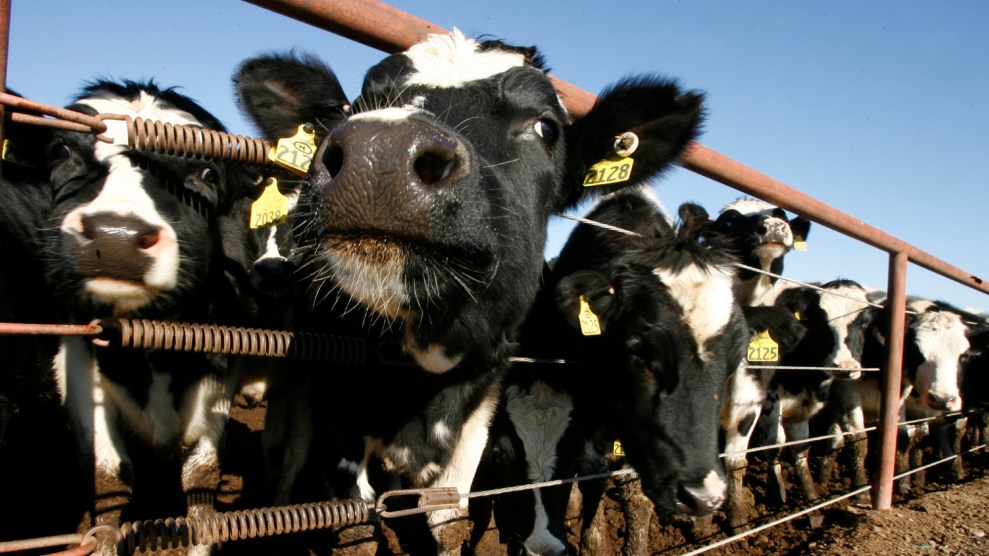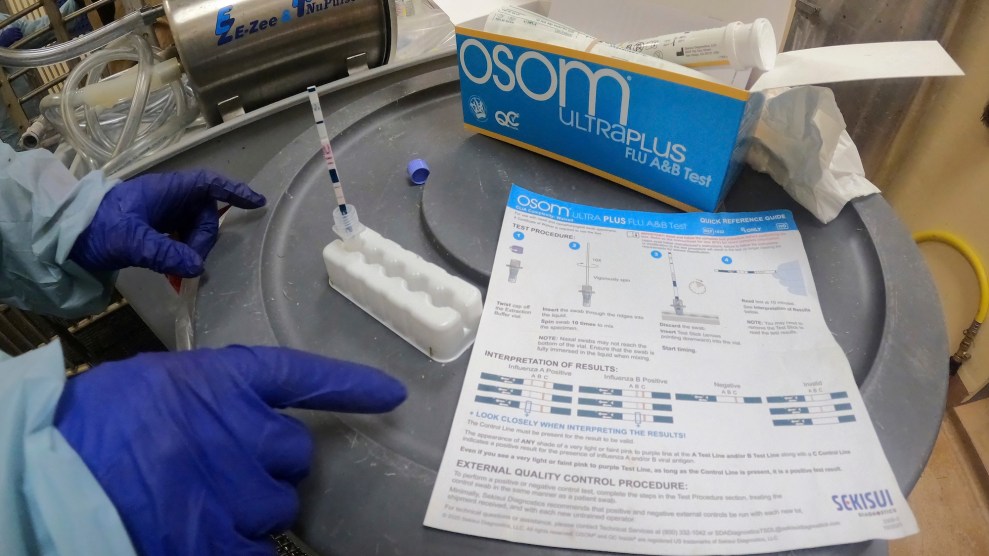
Some cows are experiencing milk production issues due to the bird flu according to experts.Liz Hafalia/San Francisco Chronicle via AP
On Wednesday, California became the first state to issue a declaration of emergency regarding the avian flu (H5N1). That same day, the Centers for Disease Control and Prevention (CDC) confirmed the first severe case of the flu in a human on US soil and outbreaks in cow herds were detected in Southern California.
Still, the threat to humans is low according to the CDC. The agency has traced most human infections back to those handling livestock, and there’s been no reported transmission between people.
“I have dairies that are never coming back from this.”
But for cows and the dairy they produce, it’s a different story. This year was the first time the flu was detected in cows in the US, and it has ripped through many Western states’ dairy farms with startling speed. Since March, the virus has been found in cow herds of 16 states. For the last few months, infected herds have largely been concentrated in California—the state that makes up about 20 percent of the nation’s dairy industry. Last week, Texas, another one of the nation’s top dairy producing states, saw the reappearance of bird flu after two months without a detected outbreak.
In the industry hit hardest by bird flu, the poultry industry, the virus’ spread has resulted in the culling of entire flocks which has lead to higher egg prices on supermarket shelves. Will milk and butter prices soon go the same route? And how worried should you be about consuming dairy?
How exactly does bird flu affect dairy cows?
Some farmers are first identifying outbreaks in their herds through the color and density of the milk, in what they are coining “golden mastitis,” according to Milkweed, a dairy news publication. As early studies by University of Copenhagen researchers found, the virus latches onto dairy cows mammary glands, creating complications for the dairy industry beyond just the cow fatalities.
The virus is proving deadly to cows. According to Colorado State University Professor Jason Lombard, an infectious disease specialist for cattle, the case fatality rates based on a limited set of herds was zero to 15 percent. But California saw an even higher rate of up to 20 percent during a late summer heatwave in the states Central Valley. It was a warning for how the rising number of heatwaves and temps across the country could result in deadlier herd outbreaks in upcoming summers.
For some of the cows that survived, there was a dip in their dairy production of around 25 percent according to multiple experts I spoke with. As a farmer told Bloomberg News, some of the cows aren’t returning to full production levels, an indication of longer lasting effects of the virus. It’s a finding experts are seeing in other parts of the US, too. According to Lombard, this may be due to the severity of the virus in the cow. According to reporting in Milkweed, there may also be “long-tail” bird flu impacts on a cow’s dairy production, health, and reproduction. Additional research is likely needed to understand the extent of these potential longterm effects of the virus and whether they could spell trouble ahead for recovering farms.
A spokesperson with the California Department of Food and Agriculture told Mother Jones, “it’s too soon to know how production has been impacted.”
How is this impacting farms and farm workers?
As of today, more than half of the people who’ve contracted H5N1 are dairy farmworkers, according to the CDC. This population is particularly vulnerable because they are often the ones handling milking or milking equipment which can lead to spreading the virus. The CDC is recommending employers take steps to reduce their workers’ exposure to the virus by creating health and safety plans.
The CDC is working with organizations like the National Center for Farm Worker Health to expand testing, PPE availability, and training. According to Bethany Alcauter, a director at the organization, ensuring dairy farmworkers have access to testing is a tricky situation. The 100,000-some workforce faces barriers to accessing health care and testing, such as an inability to take paid-time off to get themselves tested if they are sick. And the system depends on the producer to decide to bring in the health department to oversee potential outbreaks within herds and staff, which doesn’t always happen because there’s no government mandate.
“It’s all recommendations and kindness—that’s what we’re running on. It’s not regulation and enforcement.”
“It’s all recommendations and kindness—that’s what we’re running on,” Alcauter says. “It’s not regulation and enforcement.” She believes the testing infrastructure could be strengthened by “recognizing that farm workers can be public-health first responders if they have the knowledge and the access to the right contacts, in the right system.”
Outside of navigating farmworker health, farmers face economic impacts when the virus spreads through their herds. “What you’re losing at the end of the day is revenue for your farm when it rolls through,” says Will Loux, vice president of economic affairs for the National Milk Producers Federation. “Depending on the financial situation of an individual farm it can certainly be devastating.”
There are a handful of variables and factors that shape the financial losses of a dairy hit with an outbreak. Luckily, agriculture economist Charles Nicholson at the University of Wisconsin-Madison and some colleagues created a calculator to estimate this financial impact of a bird flu outbreak. Based on Nicholson’s estimates for California, a typical farm of 1500 cattle will lose $120,000 annually. For context, this is about $10,000 more than the median household income of a dairy farmer. Based on those estimates, that would mean California’s farmers have collectively lost about $80 million at most due to avian flu so far. The US Department of Agriculture is providing support for farmers who are impacted by H5N1 outbreaks.
In reviewing a few herd datasets in Michigan, Phillip Durst, a dairy and cattle expert, noted that about half a year after an outbreak, herds were producing around 10 percent less than before. Not only do farmers face massive short term losses, they also struggle to return to full capacity again. And, there are high costs associated with putting resources into taking care of sick animals too.
Even strong diaries that had “tip top” biosecurity measures, or comprehensive environmental protection measures in place, are shutting down, according to Anja Raudabaugh, CEO of Western Untied Dairies, a trade organization overseeing farms across California. “I have dairies that are never coming back from this,” Raudabaugh says. “This was just so cataclysmic for them. They’re not going to be able to get over that loss in production hump.”
There is some hope around the corner. A vaccine for cows, which the USDA claims is in the works, could help stop the spread and protect remaining uninfected herds. “Until we have a vaccine that we can inoculate them with at an early age, we have no choices except to hope that herd immunity sets in soon,” Raudabaugh says.
What’s the effect on milk?
In June, the US dropped 1.5 percent in production, around 278 million pounds of milk, compared to 2023. It was one of the early potential indicators of the industry’s vulnerability to this virus. However, since then, the nation’s production rebounded to above 2023 numbers. It’s largely why consumers are not seeing the same impact on the price and availability of dairy products like they are with eggs.
“When one state gets H5N1 there are a lot of other states that tend to pick up the slack. So in general, when you look at the national numbers, you really have to squint to kind of find where H5N1 is in the milk production”,” says Loux.
California produces around a fifth of the nation’s dairy, and since August over half of the state’s herds had an outbreak. In October, California saw a near four percent drop in milk production compared to 2023, equating to about 127 million pounds of milk.
On Thursday, the USDA released November’s data on milk production showing California with the largest decrease this year of 301 million fewer gallons of milk compared to 2023. That is more than double the decrease of last month. Still, the nation only saw a near 1 percent decrease since 2023.
How the next administration handles this virus may spell a different story for the dairy industry and the country. With Trump’s history of downplaying infectious diseases and promoting unfounded cures, and public health cabinet nominations who decry vaccine effectiveness, a human-to-human outbreak could lead to another pandemic. Likely to take over the USDA is Brooke Rollins, who, according to Politico, had less experience in agriculture than others on Trump’s shortlist (though she does have a degree in agriculture development). It’s currently unclear what her plans are for handling this virus and supporting farmers and the industry at large. Rollins did not respond to my request for an interview.
Should I be worried about getting sick from drinking milk?
Drinking pasteurized milk is safe. For more than 100 years, pasteurization has kept the public safe by killing harmful bacteria and viruses.
The CDC is warning against raw milk consumption, on the other hand, due to it potentially having high-levels of bird flu. While there’s yet to be a human case of bird flu traced to raw milk consumption, there is fear that the unpasteurized product could lead to illness. And raw milk loaded with the virus has been linked to deaths in other mammals, like cats.
Robert F. Kennedy Jr, the likely soon-to-be director of Health and Human Services under Trump, has a history of promoting raw milk. Earlier this month, Kennedy’s favorite raw milk brand was recalled by California after testing positive for bird flu. Kennedy’s rise to public health power comes at time when raw milk is rising in popularity on TikTok.
In response to the spread of bird flu in raw milk, the USDA announced a national strategy requiring milk samples nationwide be tested by the agency. Since officially beginning testing on Monday, 16 new bird flu outbreaks in cow herds have been identified in two states.
For now, as the nation continues to work on controlling the spread of bird flu, consider tossing your raw milk out before it does more than just spoil.
















